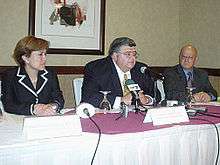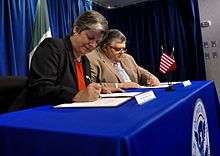Agustín Carstens
| Agustín Carstens | |
|---|---|
 | |
| Governor of the Bank of Mexico | |
|
Assumed office 1 January 2010 | |
| Preceded by | Guillermo Ortiz Martínez |
| Secretary of Finance | |
|
In office 1 December 2006 – 9 December 2009 | |
| President | Felipe Calderón |
| Preceded by | Francisco Gil Díaz |
| Succeeded by | Ernesto Cordero |
| Personal details | |
| Born |
9 June 1958 Mexico City, Mexico[1] |
| Spouse(s) | Catherine Mansell[2] |
| Alma mater |
Mexico Autonomous Institute of Technology University of Chicago |
Agustín Guillermo Carstens Carstens (born 9 June 1958 in Mexico City), is a Mexican economist who has served as Governor of the Bank of Mexico since 1 January 2010.[3] In 2011, Carstens, along with Christine Lagarde, was one of the two final candidates to become the managing director of the International Monetary Fund.[4] He previously served as Secretary of Finance in the cabinet of Felipe Calderón (2006–09), as deputy managing director of the International Monetary Fund (2003–06)[1] and as Treasurer of the Bank of Mexico. In 2011 he was included in the 50 Most Influential ranking of Bloomberg Markets Magazine.
On 1 December 2016, it was announced that in July 2017, Carstens will leave the Bank of Mexico to become the General manager at the International Bank of Settlements in Basel, Switzerland, he was appointed to a five-year term, effective 1 October 2017.[5][6]
Early years
Carstens graduated with a bachelor's degree in Economics from the Autonomous Technological Institute of Mexico (ITAM). After working as an intern in the Bank of Mexico he received a scholarship and completed both a master's degree (1983) and a doctorate in Economics (1985) at the University of Chicago.[7] His thesis advisor was Michael Mussa, former Economic Counselor and Director of the Department of Research at the International Monetary Fund from 1991 to 2001.[8]
He is married to Catherine Mansell, an academic, writer and economist from the United States who has authored several books on finance and on literary fiction and nonfiction under the pen name C. M. Mayo.[2]
In the mid-1980s Carstens returned to Mexico and rejoined the Bank of Mexico. Before turning 30 he was appointed Treasurer, effectively taking charge of the national reserves. Rising through the ranks in the early 1990s, he was appointed Chief of Staff of chairman Miguel Mancera, and served as Director-General of Economic Research at the end of the 1990s, in charge of designing the Bank's economic policy with governor Guillermo Ortiz Martínez in the aftermath of the Tequila Crisis and the Russian default crisis. While at the Bank he produced several research articles about the Mexican economy and, in particular, co-authored an analysis of the Mexican Crisis along with then Deputy Governor Francisco Gil Díaz, which suggests the Mexican crisis was to a large extent an avoidable run on the Mexican peso brought about by external circumstances and political problems.[9]
International Monetary Fund


After many years at the Bank of Mexico, Carstens took a position at the IMF and served as the deputy managing director —one of three deputies reporting to the director and the board— from 1 August 2003 to 16 October 2006.[1]
Carstens left the IMF to coordinate the economic policy program of Felipe Calderón, then president-elect of Mexico, who appointed him as secretary of finance shortly after the election was validated.[10]
Secretary of Finance
On 26 March 2007, Carstens was additionally appointed as new chairman of the joint World Bank/IMF Development Committee, a position customarily occupied by a developing country Finance Minister.[11]
As Secretary, Carstens took the unconventional decision to hedge Mexico's oil earnings for 2009 against possible price falls, leading to an $8 billion profit for the country.[12]
In the aftermath of the 2007 popular protests against rising food prices, Carstens regarded high food prices as a positive driver for investment in agriculture.[13]
Bank of Mexico
Carstens was nominated to the Bank of Mexico on 9 December 2009 by President Felipe Calderón,[14] replacing 12-year veteran Guillermo Ortiz, who reduced inflation from double digits to an expected 4 percent by the end of 2009.[15] He was confirmed by the Senate on 15 December 2009 with 81 votes in favor and 19 votes against.[3]
Economic views
He identifies five characteristics of business cycles in emerging economies that distinguish them from those in industrialized nations:[16]
- Business cycles in emerging economies are strongly tied to those in industrialized nations.
- Cycles in emerging economies are more volatile
- Volatility of emerging economies can be affected by additional factors that don't affect industrialized economies, such as price fluctuations
- Rapid capital outflows made possible under corporate globalization can have severely harmful effects on emerging economies
- Emerging economies are subject to the problems associated with exchange-rate regimes
Carstens claims that the solution to these problems is for emerging nations to:[16]
- Adopt more open trade and investment regimes
- Allow market control of interest rates
- Ensure that their banks are robust enough to handle severe macroeconomic changes
- Enact structural changes such as central bank autonomy, privatization of production, reduced regulations over labor markets, and reduced dependence on foreign savings
References
- 1 2 3 "Agustín Carstens: Biographical Information". International Monetary Fund. 15 May 2007. Retrieved 2 December 2008.
- 1 2 "Catherine Mansell, el apoyo de Carstens" (in Spanish). El Universal. 16 October 2006. Retrieved 16 October 2006.
- 1 2 Rojas, Luis; Grebler, Dan & Craft, Diane (15 December 2009). "Mexico's Senate confirms Carstens as cenbank head". Forbes. Reuters. Retrieved 15 December 2009.
- ↑ "IMF shortlists Christine Lagarde and Agustin Carstens". BBC News. 13 June 2011.
- ↑ "Bank of Mexico's Agustín Carstens Leaving to Lead Bank for International Settlements". The Wall Street Journal. 1 December 2016. Retrieved 2 December 2016.
- ↑ "Agustín Carstens renuncia al Banco de México" (in Spanish). El Universal. 1 December 2016. Retrieved 2 December 2016.
- ↑ Cárdenas Estandía, Rogelio (17 October 2006). "Entrevista a Agustín Carstens" (in Spanish). El Financiero. Retrieved 2 December 2008.
- ↑ Carstens, Agustín (September 2005). "IMF Conference in Honor of Michael Mussa: MussaFest — Opening Remarks". IMF Staff Papers. International Monetary Fund. pp. 1–5. Archived from the original on 2 February 2009. Retrieved 10 June 2011.
I took several courses with Mike, and he was generous enough to direct my thesis dissertation in the mid-1980s.
- ↑ Carstens, Agustín; Gil Díaz, Francisco. "Some Hypotheses RelatedTo The Mexican 1994-95 Crisis" (PDF). Bank of Mexico. Retrieved 5 March 2012.
- ↑ "Mexico's Calderon names Carstens finance minister". Reuters. 21 November 2006. Retrieved 21 November 2006.
- ↑ "Mexico's Minister of Finance Agustin Carstens Becomes Development Committee Chairman". World Bank. 27 March 2007. Retrieved 23 September 2009.
- ↑ Blas, Javier (7 September 2009). "Mexico to enjoy $8bn windfall from oil bet". Financial Times. Retrieved 23 September 2009.
- ↑ "Cable Viewer". Wikileaks.org. 2008-07-16. Retrieved 2013-10-16.
- ↑ Gould, Jens; Martínez, Andrés (9 December 2009). "Calderon Nominates Carstens for Mexico Central Bank". Bloomberg. Retrieved 9 December 2009.
- ↑ Malkin, Elisabeth (9 December 2009). "New Chief Nominated for Mexico's Central Bank". New York Times. Retrieved 9 December 2009.
- 1 2 Fuhrer, Jeffrey C. & Schuh, Scott (2002). "Beyond Shocks; What causes business cycles?; An Overview". In Rabin, Jack & Stevens, Glenn L. Handbook of monetary policy. CRC Press. pp. 21–22. ISBN 978-0-8247-0578-7.
External links
| Wikimedia Commons has media related to Agustín Carstens. |
| Political offices | ||
|---|---|---|
| Preceded by Francisco Gil Díaz |
Secretary of Finance 2006–2009 |
Succeeded by Ernesto Cordero |
| Business positions | ||
| Preceded by Guillermo Ortiz Martínez |
Governor of the Bank of Mexico 2010–present |
Incumbent |